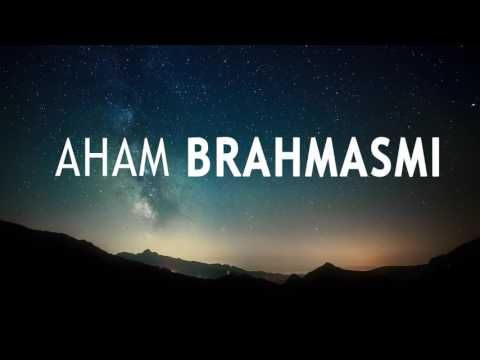
The simple translation of Aham Brahmasmi is that I am Brahma. People often fall prey to a misunderstanding upon hearing this. The reason for this is that people follow the dictates of rational interpreters. To know the meaning of any assertion, it is necessary to understand its predecessor. The Upanishads or its only authentic commentator Adi Shankaracharya did not want to generate any kind of blind faith or confusion in any person’s mind.
Contents
Definition Of ‘Aham Brahmasmi’:

The word came from the Sanskrit words, aham, which means “I” and Brahma, which means “sacred” or “divine,”. Since Brahma is the Hindu creator god (universal energy), the word “Asmi” means “I am.”
So, Aham Brahmasmi is a word that is utilized in Hindu and yoga philosophy. This word describes the harmony of the Atma (individual soul or higher self) with Brahman (which is the Absolute). It’s typically summarized as “I am Brahman” or “I am divine.” This reflects the supreme goal of yoga – association with the self.
Meaning of Aham Brahmasmi (I Am Brahma)

Aham Brahmasmi is usually summarized as “I am God.” Directly taken, the term is closer to the declaration “I am fullness,” or “I am wholeness,” as you can break the phrase down into 3 components:
- Aham typically translated as “I”
- Brahma means “Fullness,” or “Wholeness”
- Asmi means “am”
Often Jnana yoga practitioners use this phrase during their meditation practice. The term expresses a central composition of Advaita philosophy. Advaita tradition connects the macrocosmic ideas of God as well as all that’s with the self-exploration you undergo your entire life.
More Recommended Articles:-
- Meditation Symbols & Their Meanings
- What Is Deep Sleep Meditation & How Does It Work?
- What Is Reiki Meditation & How Does It Work?
- What Is Jedi Meditation & How Does It Work?
- What Is Miracle Meditation & How Does It Work?
- What Does It Mean By Abraham Hicks Meditation?
- What Does It Mean By Meditation Art?
- What Does It Mean By Third Eye Meditation?
- Tatvamasi (Tat Tvam Asi): Mahavakya Meaning
- Sat Chit Ananda | Realization Of Soul
- Meaning & Significant Of Om Mani Padme Hum
- What Is Vedic Meditation: How It Work
Benefits of Aham Brahmasmi Mantra Chanting:

The notion that makes a person dependent on religion. For example, what a human being can do is someone else. The ritualistic understanding of the philosophy, according to which the deity gives the fruits, is the method of ritualism.
That philosophy despises and subjugates power – the deity, mantra, and religion are superior. A human being has no choice but to be defeated and desperate. This assertion challenges the dominance of Priests in religion and the ‘Earth-inferior’ of ritual.
The philosophy of Sankhya philosophy is that the person (jiva) does nothing himself, whatever he does – nature. Even if a person puts nature in bondage, a man also gives nature to a man who is liberated.
FINAL WORDS
Since in the Hindu realization, Prajnanam Brahma refers to God, or All That Is, thus, the translation “I am universal energy,” or “I am God,” is possibly the most correct explanation. The definition behind the great sayings Aham Brahmasmi is way more complicated, and many masters would say that one can just understand its entire meaning via inner insight and individual meditation.
The central theme is that everyone is a microcosm part of this universe. It means you and also everything that you undergo, in nature, the identical field of energy. You’re intimately connected to this energy, as well as can’t be detached from it. Quite literally, in essence, you hold everything in the universe.
So, Aham Brahmasmi is among the major Mahavakyas in India- the short statements comprehended as the “Great Utterances” from the Upanishads.
FAQ:
![]()
Q. What does Aham Brahmasmi mean?
A. The simple translation of Aham Brahmasmi is that I am Brahma. People often fall prey to a misunderstanding upon hearing this. See the details below…
Q. Who gave the mantra of Aham Brahmasmi?
A. Adi Shankaracharya, who gave the mantra of ‘Aham Brahmasmi’, emphasized his assessment.




